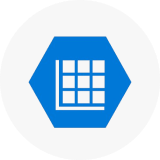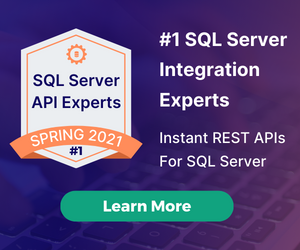How to Build React Apps Quickly and Securely Against .NET Backend Using DreamFactory (2025 Guide)
by Kevin Hood • November 18, 2025
Why Use DreamFactory for This Scenario?
When building modern React applications that need to interact with existing enterprise infrastructure, organizations often face several challenges:
Common Integration Challenges:
- Multiple authentication mechanisms: .NET APIs might use API keys, databases require connection credentials, and SOAP services have their own authentication schemes
- Inconsistent API patterns: Different backend systems expose data in different ways (REST, SOAP, direct database access)
- Security complexity: Managing CORS, rate limiting, and access controls across multiple systems
- Development overhead: Writing and maintaining custom middleware or backend services to orchestrate these connections
How DreamFactory Provides Value:
- Single API Gateway: DreamFactory sits between your React app and all backend systems, providing one consistent REST interface. Your React app only needs to know one base URL and one authentication pattern.
- Instant API Generation: Instead of writing custom API endpoints for database access, DreamFactory auto-generates fully documented REST APIs for your SQL Server, Oracle, or other databases with full CRUD operations.
- Legacy System Modernization: SOAP services and legacy systems are automatically wrapped as clean JSON REST APIs, eliminating the need for React to handle XML parsing or complex SOAP protocols.
- Unified Security Model: One role-based access control (RBAC) system manages permissions across all services. Define once what a user or application can access, and it applies to databases, APIs, and legacy systems uniformly.
- Reduced Development Time: No need to build custom middleware, authentication layers, or API aggregation services. DreamFactory handles the plumbing so developers can focus on the React UI.
- Built-in Features: Automatic API documentation (Swagger/OpenAPI), request logging, rate limiting, and CORS management come out of the box.
For organizations with existing .NET infrastructure, databases, and legacy SOAP services, DreamFactory eliminates months of custom integration work and provides a production-ready API layer that's secure, documented, and maintainable.
Note: This guide references DreamFactory official documentation (docs.dreamfactory.com and guide.dreamfactory.com). For advanced features, consult DreamFactory support.
1. Prerequisites
- Running DreamFactory instance (Docker, VM, cloud, etc.).
- Access to:
- Base URL(s) of existing .NET APIs
- Any databases or SOAP services you want to include.
- DreamFactory admin credentials.
- Node.js + npm/yarn on your dev machine (for React).
2. Inventory Existing Backends
Before building anything, make a quick list:
- .NET APIs
- Base URLs (e.g., https://api.customer.com/orders)
- Auth style (Basic, API key, OAuth2, etc.)
- Any OpenAPI/Swagger docs available
- Databases
- SQL Server / Oracle / others
- Legacy/SOAP APIs
- WSDL URLs
- Any special auth
You'll map each of these to one or more DreamFactory services.
3. Wrap .NET APIs with DreamFactory HTTP Services
You'll use DreamFactory's HTTP Service connector to proxy your .NET APIs through DreamFactory. The HTTP Service connector is used to proxy third-party HTTP APIs through DreamFactory, opening up possibilities for creating sophisticated API-driven applications and powerful workflows involving multiple APIs.
Step 3.1 – Create an HTTP Service
- Log into your DreamFactory instance.
- Click on the Proxy a Web Service from the home page
- Choose HTTP Service from the Service Type drop down.
- Assign the service details (See sample below):
- Name: dotnet_orders (must use alphanumeric characters only; this name becomes part of your API URI structure)
- Label: "Orders API" (human-readable label for reference)
- Description: "Proxy for .NET Orders REST API" (optional referential information)
This creates DreamFactory endpoints with the structure:
/api/v2/dotnet_orders/<path>
Where <path> will be appended to your base URL when making requests to the remote .NET API.
Step 3.2 – Configure the HTTP Service
- Enter the Base URL for your .NET API (e.g., https://api.customer.com/orders)
Note: When a client makes a request to your DreamFactory service, DreamFactory will append everything after /dotnet_orders in the service URL to the base URL before forwarding the request to the remote web service. DreamFactory acts as a proxy for the remote web service.
Important benefit: Web service credentials are never exposed to the client since they're configured and stored in DreamFactory.
Step 3.3 – Add Parameters (Optional)
If your .NET API requires query parameters (like API keys), Click the Advanced Options drop down and scroll down to the Parameters section and click the + (plus sign) on the right side:
Configure each parameter:
- Name: The parameter name (e.g., api_key)
- Value: The parameter value
- Exclude: Check this to prevent a parameter passed from the client from being sent to the remote service
- Outbound: Check this to add the parameter before DreamFactory calls the remote service
- Cache Key: Optionally cache the parameter for performance
- Action: Select which HTTP verbs (GET, POST, PUT, PATCH, DELETE) this parameter applies to
Parameter behavior:
- Outbound: The parameter will be passed to the destination API
- Exclude: Prevents a client-provided parameter from being forwarded to the destination
Step 3.4 – Add Headers for Authentication
Headers are the preferred method for passing authorization credentials because they are encrypted when HTTPS is used (unlike parameters which can be intercepted or logged).
To add a header, click the + (plus sign) on the right side of the Headers section:
Configure each header:
- Name: The header name (e.g., Authorization, X-API-Key)
- Value: The header value (e.g., Bearer {token}, your API key)
- Pass From Client: Check this to pass a header from the requesting client through to the remote service
- Action: Select which HTTP verbs this header applies to
Header options:
- Pass From Client: Useful if your React clients need to pass their own custom headers through DreamFactory to the .NET service
- Fixed value: If unchecked, the header value you specify will be added to all requests to the remote service
Step 3.5 – Save Your Service
Click Save to persist your HTTP Service configuration.
Step 3.6 – Calling Your .NET API Through DreamFactory
Once configured, your React app will make requests to:
GET https://your-dreamfactory-domain/api/v2/dotnet_orders/{endpoint}
POST https://your-dreamfactory-domain/api/v2/dotnet_orders/{endpoint}
DreamFactory will forward these requests to your .NET API at:
GET https://api.customer.com/orders/{endpoint}
POST https://api.customer.com/orders/{endpoint}
All configured parameters and headers are automatically included in the outbound request to your .NET API.
Step 3.7 – (Optional) Add Service Definition for Enhanced Documentation
DreamFactory supports adding OpenAPI/Swagger definitions for HTTP Services. This provides:
- Detailed API documentation in the Live API Docs
- Better understanding of available endpoints and parameters
- Enhanced role-based access control at the path level
If your .NET API provides OpenAPI/Swagger documentation, you can add this definition in the Service Definition section of the Config tab. Consult DreamFactory support or community resources for detailed instructions on importing API definitions.
Note: Unlike database or file storage services, HTTP services in DreamFactory do not auto-generate Swagger documentation without a service definition, as DreamFactory cannot automatically discover the structure of remote APIs.
4. Connect Databases Directly to DreamFactory
For any DBs you want React to hit (avoiding extra .NET plumbing):
- Home Page → Click on Connect to Database.
- Choose the DB type (e.g., SQL Server).
- Enter connection info (host, db, user, password, etc.).
- Save
DreamFactory auto-generates full REST CRUD over tables/views:
GET /api/v2/sqlserver/_table/customers
POST /api/v2/sqlserver/_table/customers
PATCH /api/v2/sqlserver/_table/customers/123
DELETE /api/v2/sqlserver/_table/customers/123
Useful Query Parameters:
- filter - Add WHERE clauses (e.g., ?filter=status='active')
- fields - Select specific columns (e.g., ?fields=id,name,email)
- related - Include related table data via foreign keys
All with OpenAPI docs and RBAC guardrails.
5. Wrap SOAP / Legacy Services as REST (Optional)
For SOAP or older web services:
- Services → Create → Remote Service → SOAP Service
- Provide the WSDL URL in the "WSDL" field
- DreamFactory will parse operations and generate REST endpoints that call SOAP under the hood
Result: React sees simple JSON REST; DreamFactory handles all SOAP XML ugliness.
6. Configure Security: Roles, Apps, API Keys
Now make the React app's access secure but simple.
Step 6.1 – Create a Role for the React App
- In the left navbar, click Role Based Access.
- Click the + (purple plus button) to create a new Role.
- Enter:
- Name: react_frontend
- Description: "Role for React portal application"
- Check Active
- Click the Access Overview dropdown/arrow.
- Configure service access for each service the React app needs:
For the HTTP Service (wrapped .NET API):
- Service: Select dotnet_orders (your HTTP service name)
- Component: Enter /* (for all paths) or specific path like /orders/*
- Access: Select the HTTP methods needed (GET, POST, PATCH, DELETE)
- Requester: Select API
For Database Service:
- Service: Select sqlserver (your database service name)
- Component: Enter _table/* (all tables) or _table/customers (specific table)
- Access: Select the HTTP methods needed (GET, POST, PATCH, DELETE)
- Requester: Select API
For SOAP Service (if added):
- Service: Select your SOAP service name
- Component: Enter /* or specific operation path
- Access: Select the HTTP methods needed
- Requester: Select API
- Click the + sign next to Advanced Filters to add additional service access rows as needed.
- Click Save to create the role.
Note: The Requester field determines if the service can be accessed via API calls, server-side scripts, or both. For React applications, select API.
Note: Depending on your Role Based Access Control requirements, it might make sense to create multiple Roles across your different API services. This example only uses one Role.
Step 6.2 – Create an App & API Key
- In the left navbar, click Apps (or API Keys).
- Click the + (purple plus button) to create a new App.
- Fill in:
- Application Name: react-portal
- Description: "React portal application"
- Check Active
- App Location: Select No Storage Required (for web/mobile apps)
- Assign a Default Role: Select react_frontend (the role you just created)
- Click Save.
DreamFactory automatically generates an API key for this App. Copy this key - you'll need it in your React application.
Important: Each App has one API key. The role assigned to the App determines what resources can be accessed using that API key.
Step 6.3 – Understanding JWT Session Tokens (User Authentication)
For user-specific authentication (not just app-level):
- API Key (X-DreamFactory-Api-Key header): Identifies which App is making the request and determines base permissions via the App's default role
- Session Token (X-DreamFactory-Session-Token header): Identifies which User is making the request (obtained by authenticating via /user/session endpoint)
How it works:
- User logs in via /user/session with email/password
- DreamFactory returns a JWT session token in the response (session_token field)
- Subsequent requests include both headers:
- X-DreamFactory-Api-Key: Your App's API key
- X-DreamFactory-Session-Token: The user's session token
- DreamFactory combines the user's role permissions with the App's role permissions
Authentication patterns:
- Unauthenticated access: Only X-DreamFactory-Api-Key → Uses App's default role
- Authenticated access: Both X-DreamFactory-Api-Key + X-DreamFactory-Session-Token → Uses user-specific permissions
Each user can be assigned a role per App in the Users tab of the admin console. If no user-specific role is assigned, they inherit the App's default role.
7. Test Everything in Live API Docs
Before touching React, verify the API layer from DreamFactory's admin.
- Go to API Docs (Live API Docs).
- Pick:
- dotnet_orders (wrapped .NET API)
- sqlserver (DB service)
- soap_legacy (SOAP wrapper, if you added one)
- Add your API key (and session token once you set auth up).
- Test a few calls.
If these work here, they'll work from React.
8. Build the React App (Talking Only to DreamFactory)
Now assume:
- DreamFactory is reachable at: https://api.customer.com/api/v2
- App API key: DF_APP_KEY (never commit to repo; use environment variables for deployment)
Step 8.1 – Create the React App
Example with Vite + React:
npm create vite@latest react-portal -- --template react
cd react-portal
npm install
Create a .env.local file (for development only, never commit):
VITE_DF_BASE_URL=https://api.customer.com/api/v2
VITE_DF_APP_KEY=your_app_key_here
Production Note: Use your deployment platform's environment variable system (not .env files) to inject these values securely.
Step 8.2 – Helper for Calling DreamFactory
// src/dreamfactoryClient.js
const BASE_URL = import.meta.env.VITE_DF_BASE_URL;
const APP_KEY = import.meta.env.VITE_DF_APP_KEY;
let sessionToken = null; // set after login
export function setSessionToken(token) {
sessionToken = token;
}
export async function dfRequest(path, options = {}) {
const headers = {
"Content-Type": "application/json",
...(options.headers || {}),
"X-DreamFactory-Api-Key": APP_KEY,
};
if (sessionToken) {
headers["X-DreamFactory-Session-Token"] = sessionToken;
}
const res = await fetch(`${BASE_URL}${path}`, {
...options,
headers,
});
if (!res.ok) {
const errorData = await res.json().catch(() => ({}));
throw new Error(
`DreamFactory error: ${res.status} - ${errorData.error?.message || 'Unknown error'}`
);
}
return res.json();
}
Step 8.3 – Login Against DreamFactory
DreamFactory has built-in auth endpoints (e.g., /user/session) for username/password, LDAP, OAuth, etc.
Example simple login form:
// src/Login.jsx
import { useState } from "react";
import { dfRequest, setSessionToken } from "./dreamfactoryClient";
export default function Login({ onLoggedIn }) {
const [email, setEmail] = useState("");
const [password, setPassword] = useState("");
const [error, setError] = useState("");
async function handleSubmit(e) {
e.preventDefault();
setError("");
try {
const body = { email, password };
const data = await dfRequest("/user/session", {
method: "POST",
body: JSON.stringify(body),
});
// Response includes: session_token, session_id, id, email, etc.
setSessionToken(data.session_token);
onLoggedIn(data);
} catch (err) {
setError(err.message);
}
}
return (
<form onSubmit={handleSubmit}>
{error && <div style=>{error}</div>}
<input
value={email}
onChange={e => setEmail(e.target.value)}
placeholder="Email"
type="email"
required
/>
<input
type="password"
value={password}
onChange={e => setPassword(e.target.value)}
placeholder="Password"
required
/>
<button type="submit">Log in</button>
</form>
);
}
Step 8.4 – Calling the Wrapped .NET API From React
Let's say your .NET API has an endpoint GET /orders (exposed via the HTTP Service dotnet_orders):
// src/Orders.jsx
import { useEffect, useState } from "react";
import { dfRequest } from "./dreamfactoryClient";
export default function Orders() {
const [orders, setOrders] = useState([]);
const [loading, setLoading] = useState(true);
const [error, setError] = useState("");
useEffect(() => {
dfRequest("/dotnet_orders/orders")
.then(data => {
setOrders(data);
setLoading(false);
})
.catch(err => {
setError(err.message);
setLoading(false);
});
}, []);
if (loading) return <div>Loading...</div>;
if (error) return <div>Error: {error}</div>;
return (
<ul>
{orders.map(o => (
<li key={o.id}>
#{o.id} – {o.status}
</li>
))}
</ul>
);
}
Similarly, for a DB-backed resource with query parameters:
// SQL Server table via DF DB service
// Get active customers with only id, name, email fields
dfRequest("/sqlserver/_table/customers?filter=status='active'&fields=id,name,email");
React never touches .NET or the DB directly; it only calls DreamFactory.
9. Handle CORS and Dev Environment
Option A – Enable CORS in DreamFactory
Note: CORS configuration requires environment variable setup in your DreamFactory deployment (.env file with DF_CORS_* variables). Consult your DreamFactory administrator or deployment documentation for specific configuration steps.
For development with React running on http://localhost:5173, you'll need to configure:
- Allowed origins
- Allowed methods (GET, POST, PATCH, DELETE, OPTIONS)
- Allowed headers (X-DreamFactory-Api-Key, X-DreamFactory-Session-Token, Content-Type)
Option B – Front Through a Reverse Proxy (Prod)
In production, you might:
- Put everything behind a single domain (e.g., Nginx/Ingress).
- Route /api/ → DreamFactory.
- Route / → React static site / app.
From React's perspective, it still just talks to /api/v2/... (same-origin, no CORS needed).
10. Deploy
- DreamFactory:
- Harden security: RBAC, API key rotation, rate limiting (configured per-role/per-service), logging, IP allowlists.
- Ensure environment variables are properly configured for production.
- .NET APIs & legacy systems:
- Keep them private where possible (VNet, private connections).
- Only DreamFactory should have direct access.
- React app:
- Build (npm run build) and deploy to your web host / CDN / app service.
- Point it at the production DreamFactory URL via deployment platform environment variables (not .env files).
- Never include API keys or secrets in your built JavaScript bundle.
Summary
This guide demonstrates how to:
- Use DreamFactory as a unified API gateway for .NET APIs, databases, and legacy SOAP services
- Secure access with role-based permissions and JWT authentication
- Build a React frontend that communicates exclusively with DreamFactory
Next Steps:
- Test thoroughly in DreamFactory's Live API Docs before React integration
- Implement proper error handling and loading states in your React app
- Configure production environment variables securely
- Set up monitoring and logging for your API gateway
Note: For advanced features like detailed OpenAPI imports, custom scripts, or complex authentication flows, consult DreamFactory support.
FAQs
1. Can I call multiple .NET APIs through one DreamFactory service?
Yes. Create separate HTTP Services for each base URL or use path routing; secure them with RBAC per service or path.
2. How are credentials kept out of the React client?
Secrets live in DreamFactory (headers/params). The browser sends only the app API key and optional session token; DF injects upstream auth server-side.
3. Do database APIs include OpenAPI docs automatically?
Yes. Database services auto-generate REST + OpenAPI; HTTP Services show docs if you import an OpenAPI definition.
4. What’s the difference between API key and session token?
API key identifies the app (base permissions). Session token identifies the user (user-level permissions). Both can be required.
5. How do I handle CORS in development?
Allow your dev origin, methods, and headers (API key + session token) in DF’s CORS config—or run React behind the same domain via reverse proxy.
Kevin Hood is an accomplished solutions engineer specializing in data analytics and AI, enterprise data governance, data integration, and API-led initiatives.



























